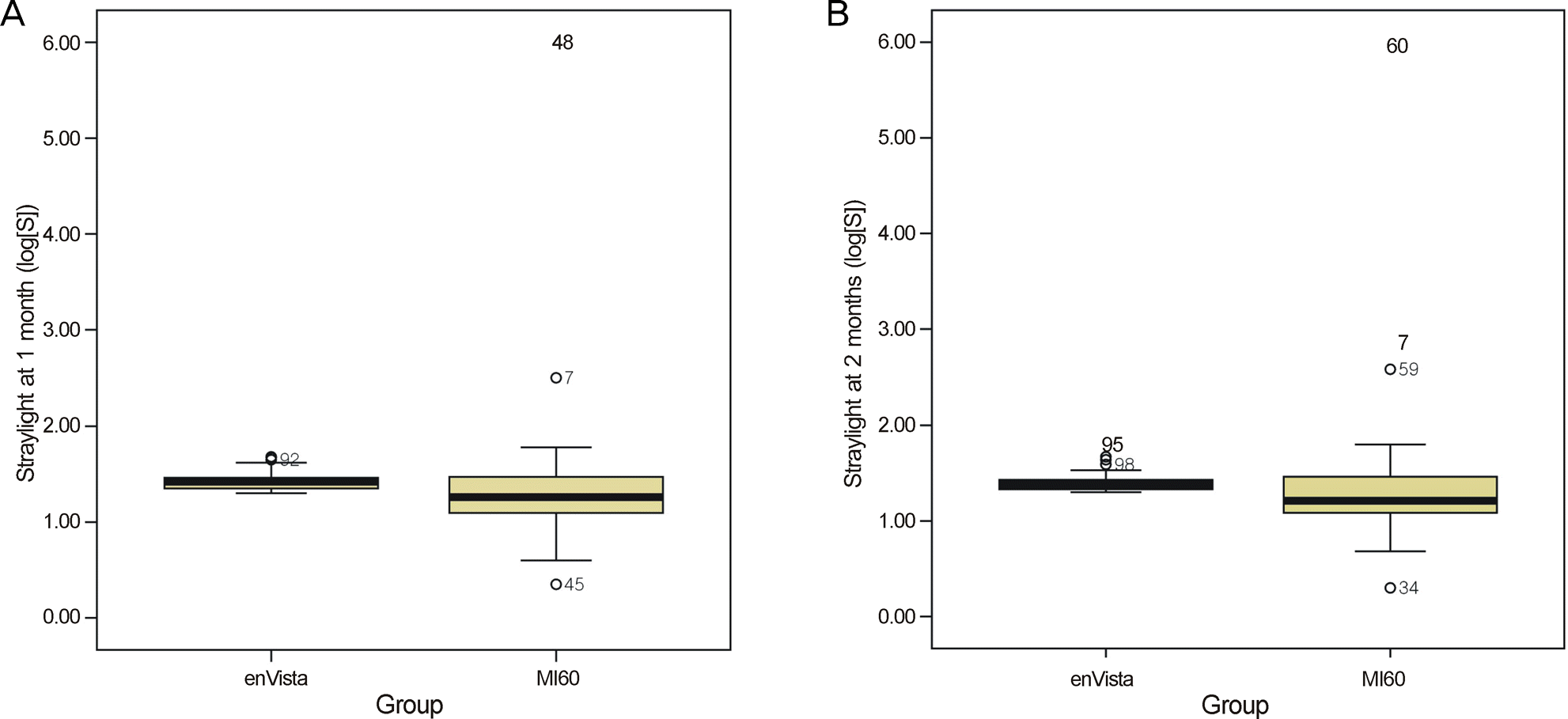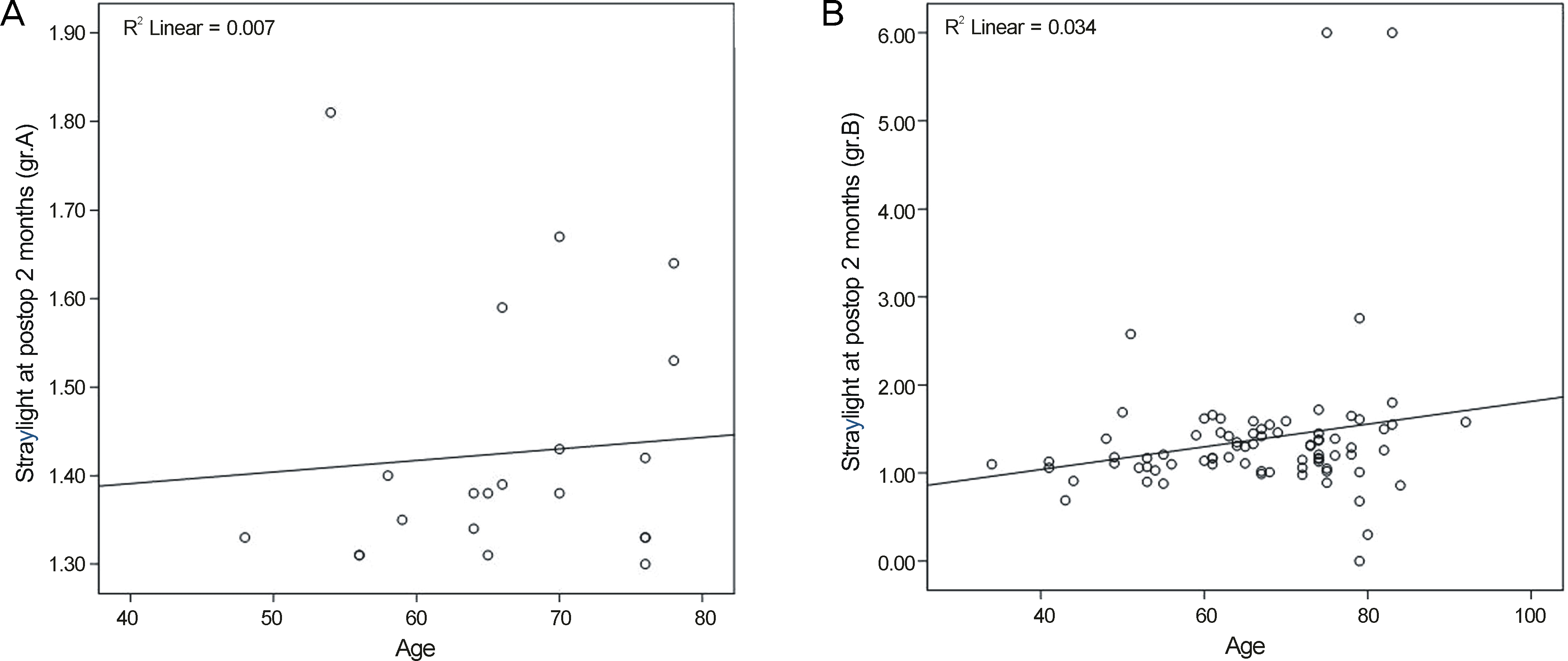Abstract
Purpose
To compare intraocular straylight between glistening-free and conventional intraocular lenses in pseudophakic eyes.
Methods
Straylight values were measured prospectively in 21 eyes with glistening-free pseudophakic lenses (group A, model enVista™, Bausch & Lomb, Inc., USA) and 79 eyes with conventional hydrophilic pseudophakic lenses (group B, model Akreos MI-60, Bausch & Lomb, Inc., USA). Best corrected visual acuity (BCVA) and straylight were measured preoperatively and 1 month and 2 months postoperatively using C-quant straylight meter (Oculus GmbH, Wetzlar, Germany).
Results
There were no statistically significant differences of BCVA preoperatively or 2 months postoperatively between the 2 groups (p > 0.05). BCVA and straylight significantly improved after the operation (p < 0.05). The mean straylight values were 1.43 ± 0.12 (log[s]) and 1.41 ± 0.16 (log[s]) for group A, and 1.33 ± 0.61 (log[s]) and 1.40 ± 0.82 (log[s]) for group B at post-operative 1 month and 2 months, respectively, with no statistical significance between the 2 groups (p > 0.05).
Go to : 
References
1. Gregori NZ, Spencer TS, Mamalis N, Olson RJ. In vitro comparison of glistening formation among hydrophobic acrylic intraocular lenses. J Cataract Refract Surg. 2002; 28:1262–8.

2. Tognetto D, Toto L, Sanguinetti G, Ravalico G. Glistenings in foldable intraocular lenses. J Cataract Refract Surg. 2002; 28:1211–6.

3. Colin J, Orignac I. Glistenings on intraocular lenses in healthy eyes: effects and associations. J Refract Surg. 2011; 27:869–75.

4. Oshika T, Shiokawa Y, Amano S, Mitomo K. Influence of glistenings on the optical quality of acrylic foldable intraocular lens. Br J Ophthalmol. 2001; 85:1034–7.

5. Werner L, Storsberg J, Mauger O, et al. Unusual pattern of glistening formation on a 3-piece hydrophobic acrylic intraocular lens. J Cataract Refract Surg. 2008; 34:1604–9.

6. Gunenc U, Oner FH, Tongal S, Ferliel M. Effects on visual function of glistenings and folding marks in AcrySof intraocular lenses. J Cataract Refract Surg. 2001; 27:1611–4.

7. Christiansen G, Durcan FJ, Olson RJ, Christiansen K. Glistenings in the AcrySof intraocular lens: pilot study. J Cataract Refract Surg. 2001; 27:728–33.

8. Franssen L, Coppens JE, van den Berg TJ. Compensation comparison method for assessment of retinal straylight. Invest Ophthalmol Vis Sci. 2006; 47:768–76.

9. Kato K, Nishida M, Yamane H, et al. Glistening formation in an AcrySof lens initiated by spinodal decomposition of the polymer network by temperature change. J Cataract Refract Surg. 2001; 27:1493–8.
10. Saylor DM, Coleman Richardson D, Dair BJ, Pollack SK. Osmotic cavitation of elastomeric intraocular lenses. Acta Biomater. 2010; 6:1090–8.

11. Nishihara H, Kageyama T, Ohnishi T, et al. Glistenings in lathe-cut acrylic intraocular lens. Ganka Shujutsu. 2000; 13:227–30.
12. Omar O, Pirayesh A, Mamalis N, Olson RJ. In vitro analysis of AcrySof intraocular lens glistenings in AcryPak and Wagon Wheel packaging. J Cataract Refract Surg. 1998; 24:107–13.

13. Dick HB, Olson RJ, Augustin AJ, et al. Vacuoles in the AcrySof in- traocular lens as factor of the presence of serum in aqueous humor. Ophthalmic Res. 2001; 33:61–7.
14. Ayaki M, Nishihara H, Yaguchi S, Koide R. Effect of ophthalmic solution components on acrylic intraocular lenses. J Cataract Refract Surg. 2007; 33:122–6.

15. Colin J, Orignac I, Touboul D. Glistenings in a large series of hydrophobic acrylic intraocular lenses. J Cataract Refract Surg. 2009; 35:2121–6.

16. Hayashi K, Hirata A, Yoshida M, et al. Long-term effect of surface light scattering and glistenings of intraocular lenses on visual function. Am J Ophthalmol. 2012; 154:240–51.

17. Elliott DB, Bullimore MA. Assessing the reliability, discriminative ability, and validity of disability glare tests. Invest Ophthalmol Vis Sci. 1993; 34:108–19.
18. IJspeert JK, de Waard PW, van den Berg TJ, de Jong PT. The intraocular straylight function in 129 healthy volunteers; dependence on angle, age and pigmentation. Vision Res. 1990; 30:699–707.

19. Behndig A, Mönestam E. Quantification of glistenings in intraocular lenses using Scheimpfl ug photography. J Cataract Refract Surg. 2009; 35:14–7.
Go to : 
 | Figure 1.Comparison of stralight between the enVista™ and MI60 groups at postoperative 1 and 2 months. (A) Straylight at post-operative 1 month. (B) Straylight at postoperative 2 months. |
 | Figure 2.Comparison of straylight with age at postoperative 2 months. EnVista™ (A), Akreos MI-60 (B). |
Table 1.
Demographics, gender, age, best corrected visual acuity (BCVA) in two groups
| Group A* (n = 21 eyes) | Group B† (n = 79 eyes) | p-value | |
|---|---|---|---|
| Sex (M:F) | 8:13 | 26:53 | 0.660 |
| Age (years) | 67.76 ± 7.09 | 66.54 ± 12.00 | 0.556 |
| BCVA (log MAR) | |||
| Pre op | 0.45 ± 0.20 | 0.46 ± 0.27 | 0.400 |
| Post op - 2 months | 0.12 ± 0.08 | 0.16 ± 0.18 | 0.554 |




 PDF
PDF ePub
ePub Citation
Citation Print
Print


 XML Download
XML Download